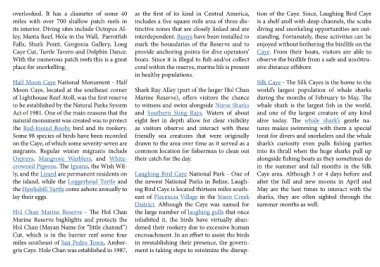Page 230 - Central America
P. 230
overlooked. It has a diameter of some 40 as the first of its kind in Central America, tion of the Caye. Since, Laughing Bird Caye
miles with over 700 shallow patch reefs in includes a five square mile area of three dis- is a shelf atoll with deep channels, the scuba
its interior. Diving sites include Octopus Al- tinctive zones that are closely linked and are diving and snorkeling opportunities are out-
ley, Manta Reef, Hole in the Wall, Parrotfish interdependent. Buoys have been installed to standing. Fortunately, these activities can be
Falls, Shark Point, Gorgonia Gallery, Long mark the boundaries of the Reserve and to enjoyed without bothering the birdlife on the
Caye Cut, Turtle Tavern and Dolphin Dance. provide anchoring points for dive operators’ Caye. From their boats, visitors are able to
With the numerous patch reefs this is a great boats. Since it is illegal to fish and/or collect observe the birdlife from a safe and unobtru-
place for snorkelling. coral within the reserve, marine life is present sive distance offshore.
Half Moon Caye National Monument - Half in healthy populations. Silk Caye - The Silk Cayes is the home to the
Moon Caye, located at the southeast corner Shark Ray Alley (part of the larger Hol Chan world’s largest population of whale sharks
of Lighthouse Reef Atoll, was the first reserve Marine Reserve), offers visitors the chance during the months of February to May. The
to be established by the Natural Parks System to witness and swim alongside Nurse Sharks whale shark is the largest fish in the world,
Act of 1981. One of the main reasons that the and Southern Sting Rays. Waters of about and one of the largest creature of any kind
natural monument was created was to protect eight feet in depth allow for clear visibility alive today. The whale shark’s gentle na-
the Red-footed Booby bird and its rookery. as visitors observe and interact with these tures makes swimming with them a special
Some 98 species of birds have been recorded friendly sea creatures that were originally treat for divers and snorkelers and the whale
on the Caye, of which some seventy-seven are drawn to the area over time as it served as a shark’s curiosity even pulls fishing parties
migrants. Regular winter migrants include common location for fisherman to clean out into its thrall when the huge sharks pull up
Ospreys, Mangrove Warblers, and White- their catch for the day. alongside fishing boats as they sometimes do
crowned Pigeons. The Iguana, the Wish Wil- Laughing Bird Caye National Park - One of in the summer and fall months in the Silk
ly, and the Lizard are permanent residents on the newest National Parks in Belize, Laugh- Caye area. Although 3 or 4 days before and
the island, while the Loggerhead Turtle and ing Bird Caye is located thirteen miles south- after the full and new moons in April and
the Hawksbill Turtle come ashore annually to east of Placencia Village in the Stann Creek May are the best times to interact with the
lay their eggs. District. Although the Caye was named for sharks, they are often sighted through the
Hol Chan Marine Reserve - The Hol Chan the large number of laughing gulls that once summer months as well.
Marine Reserve highlights and protects the inhabited it, the birds have virtually aban-
Hol Chan (Mayan Name for “little channel”) doned their rookery due to excessive human
Cut, which is in the barrier reef some four encroachment. In an effort to assist the birds
miles southeast of San Pedro Town, Amber- in reestablishing their presence, the govern-
gris Caye. Hole Chan was established in 1987, ment is taking steps to minimize the disrup-

